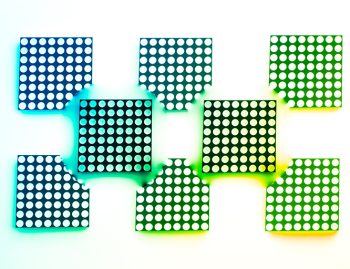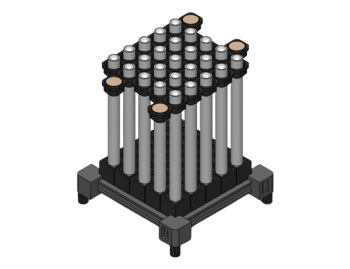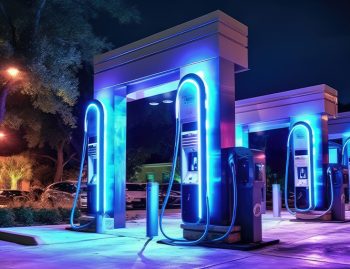
Figure 1: Light pipes are found in many EV applications (Source: Bivar)
Climate change is on everyone’s mind these days and governments around the world are taking actions to help minimize the effects. One of these is transitioning away from an economy driven by fossil fuels to one driven by renewable energy sources such as wind, hydroelectric, and solar.
Efforts to cut CO2 are driving increased adoption of electric vehicles (EVs). Global EV production is forecast to reach almost 6.4 million vehicles by the end of 2022, an increase of 34% from a year earlier. We’re not only talking about vehicles from Tesla or Chevrolet; both UPS and Amazon have ordered thousands of electric delivery vehicles from their preferred suppliers.
Of course, putting more EVs on the road is a noble goal, but it will all be for naught without sufficient chargers. As a result, installations are increasing rapidly worldwide from around 2 million in 2022 to more than 14 million forecasted by 2027 – a compound annual growth rate of over 40%.
EV charger: safety is key
EV chargers must meet a stringent set of safety requirements to protect both consumers and commercial fleet operators from the various hazards inherent in the charging process.
Operator safety is paramount. EV chargers operate from single-phase or three-phase AC power, depending on application. The vehicles themselves contain battery packs operating at bus voltages of 400V today, with 800V batteries expected to appear soon, beginning with high-performance vehicles.
The transition to electric vehicles is happening across the world, so chargers must meet a variety of global standards. In the US, chargers must be certified to UL 2231-1, “UL Standard for Safety Personnel Protection Systems for Electric Vehicle (EV) Supply Circuits”
Chargers must accommodate a variety of installation options, including being hard-wired, mounted on a wall, or mounted on a pedestal. They can be installed indoors or outdoors, so they must be rugged and resistant to dust and moisture incursion.
The role of light pipes in EV chargers
How can light pipes help EV charger designers meet these requirements?
A light pipe provides a way to display information on charger functions such as power, Wi-Fi connectivity, and charging status, while separating the operator from electronics that might contain potentially lethal voltages.
Both flexible and rigid light pipes are suitable for this application, as EV chargers come in numerous shapes and sizes.
Design considerations for an EV charger light pipe design
What are some of the requirements for an EV light pipe assembly?
A range of design options. As we’ve said, although the connector and several other features are standardized across models, the human machine interface (HMI) of EV chargers can vary widely. So it’s important that the HMI designer has a range of options. Depending on the internal configuration of the LEDs, either a rigid or flexible light pipe may be used. To reduce manufacturing time, the light pipe manufacturer may provide a complete assembly, complete with multiple light pipes, that can be installed in a single operation.
IP rating. The light pipe lens assembly must help to protect the front panel from the elements, so choosing an assembly with the appropriate Ingress Protection (IP) rating is important. An IP67 rating, for example, means that the light pipe lens cap seal protects against dust intrusion for up to eight hours. An IP67 seal can also withstand being submerged in water up to a meter deep for thirty minutes. IP67-rated light pipes come in both rigid and flexible versions.
Brightness. In many cases, the brightness of the display indication is a critical factor. One example is an EV charging station located outside where the display must be visible in bright sunlight. Another example is a fleet charging station where the charger is mounted high overhead on a charging rail.
Viewing Angle. The designer cannot be sure where the user will be located relative the display panel when operating the EV charger. There are too many variables: the location of the vehicle, the location of the vehicle charging port, etc. It’s important to design for maximum viewing angle. In a light pipe design, diffusion is used to increase the viewing angle, soften the light, and give a uniform appearance to the front panel indicator. This effect can also be provided by a lens with a semi-dome lens profile.
No light bleed. Light bleed occurs when light from an LED can be visible around the LED and light pipe area. Light bleed causes false readings, muted and blended colors, crosstalk between adjacent light pipes, and unwanted glow in the enclosure. Since an EV charger typically groups the display indications close together on the panel, it’s critical that no light bleed occur; this can cause confusion about the state of the charging system, and even pose a safety concern. The light pipe designer must therefore ensure that no light leakage occurs using a system such as Bivar’s ZeroLightBleed™ adapter technology.
Bivar and EV chargers
Not surprisingly Bivar is actively engaged in supporting the LED Indication and illumination requirements of EV charger customers. We’re applying our rugged design and environmental expertise to create high quality long-lasting solutions for electric vehicles, and non-automotive transportation, too.
Talk to a Bivar Engineer and see what Bivar can do for you?
Leave a Reply Cancel reply
You must be logged in to post a comment.









